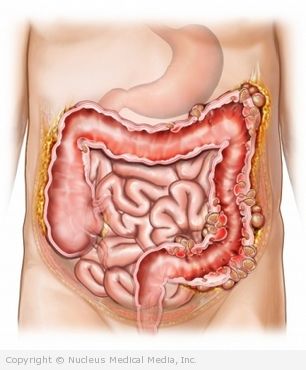(Acute Diverticulitis; Acute Colonic Diverticulitis)
Diverticulitis – Definition
A pouch that forms in the wall of the large intestine is called a diverticulum. When it becomes infected or inflamed it is called diverticulitis.

Diverticulitis – Causes
It is not clear why the pouches form. Doctors believe a constant pressure is built up when food moves too slowly through the bowel. This pressure increases then pushes along the side walls creating pouches. Digested food or stool can become trapped in one of the pouches. This leads to inflammation and infection.
The following may contribute to diverticulitis:
- Low-fiber diet — Fiber softens stools and makes them pass through the bowel more easily
- Increased pressure in the bowel from straining to pass a hard stool
- Defects in the colon wall
- Chronic constipation
Diverticulitis – Risk Factors
Factor that increases your chance of getting diverticulitis include:
- Eating a low-fiber diet
- Age: 50 or older
- Previous episodes of diverticulitis
- High meat or protein diet
- Chronic constipation
- Smoking
Diverticulitis – Symptoms
Symptoms can come on suddenly. They vary depending on the degree of the infection.
Symptoms include:
- Abdominal pain
- Tenderness, usually in the left lower abdomen
- Swollen and hard abdomen
- Fever
- Chills
- Poor appetite
- Nausea
- Vomiting
- Diarrhea
- Constipation
- Both diarrhea and constipation
- Cramping
- Rectal bleeding
Diverticulitis – Diagnosis
The doctor will ask about your symptoms and medical history. A physical and rectal exam will be done.
Finding the disease early is important. The pouch can break, releasing stool into the abdomen. This is a surgical medical emergency.
Tests may include:
- Analysis of a stool sample to look for blood
- Blood tests to look for signs of infection, inflammation, and bleeding
- X-rays to look for a rupture
- CT scan or ultrasound to locate and determine the size of the inflamed pouch
Once the inflammation subsides, other tests may be performed, including:
- Barium enema — injection of a dye into the rectum that makes your colon show up on an x-ray so the doctor can see abnormal pouches in your colon
- Flexible sigmoidoscopy — a thin, lighted camera is inserted into the rectum to examine the rectum and the lower colon
- Colonoscopy — a thin, lighted camera is inserted through the rectum and into the colon to examine the entire lining of the colon
Diverticulitis – Treatment
The goals of immediate treatment are to:
- Resolve the infection and inflammation
- Rest the bowel
- Prevent complications
Treatments include:
Medications
Antibiotics and other drugs are given to fight the infection. Pain medications and drugs are given to decrease the abdominal pain.
Fluids
For mild inflammation, you can drink clear liquids for the first two to three days. For a more severe case, you will be admitted to the hospital, where fluids are given intravenously (IV). Antibiotics will be given to you through IV. If you have nausea and vomiting, a plastic tube may be inserted through your nose into your stomach. This will help with the vomiting and make you feel more comfortable.
Preventive Care
Changes in your diet can help prevent future attacks.
- Increase the amount of fiber you eat by eating more fruits, vegetables, and whole grains
- Supplement your diet with a fiber product, as recommended by your doctor
- Avoid laxatives, enemas, and narcotic medications that can lead to constipation
Surgery
Surgery to remove the section of the bowel with pouches may be recommended if:
- You have had multiple attacks during a two-year period
- A pouch breaks and the contents spread into the abdominal cavity (will require cleaning out the abdominal cavity)
- When surgery is done on an elective basis, the surgeon will remove part of the disease bowel and hook the normal bowel together
Surgery is also used to treat complications of diverticulitis, such as:
- Abscess — occurs if the infected pouch fills with pus
- Blocked bowel — scar tissue that forms and blocks movement of stool through the intestine
- Fistula — occurs if the infection spreads and colon tissue attaches to another organ, such as the bladder or the uterus/vagina
When surgery is done on an emergency basis, the surgeon will remove the diseased bowel. Because of the serious infection, the two ends of the bowel will not be hooked together. You will most likely end up with a piece of bowel coming out to your abdomen ( colostomy). After a period of 6-12 weeks, the surgeon will go back and hook the bowel back together.
If you are diagnosed with diverticulitis, follow your doctor’s instructions.
Diverticulitis – Prevention
The following recommendations may help prevent diverticulitis by improving the movement of stool through the bowel and decreasing constipation:
- Eat a balanced, high-fiber diet with plenty of fruits, vegetables, and whole grains
- Drink plenty of water each day
- Exercise regularly
